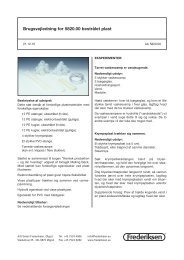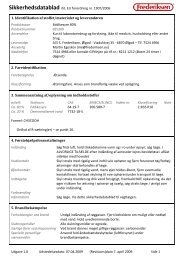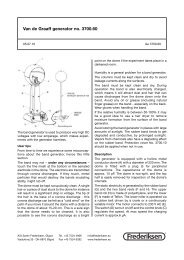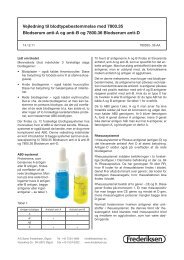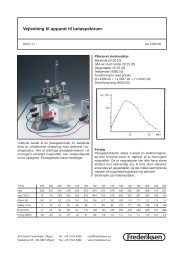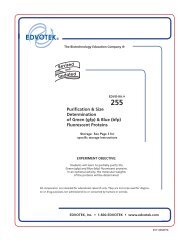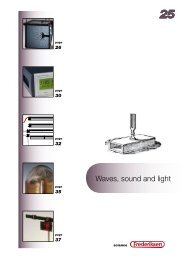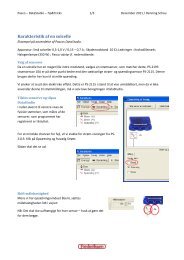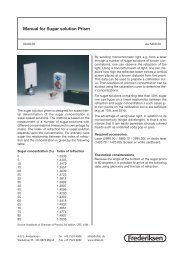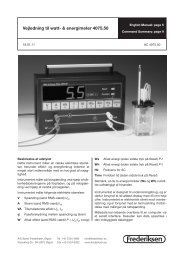Experiment Procedures - Frederiksen
Experiment Procedures - Frederiksen
Experiment Procedures - Frederiksen
You also want an ePaper? Increase the reach of your titles
YUMPU automatically turns print PDFs into web optimized ePapers that Google loves.
2EDVO-Kit # 275AIDS Kit II: Simulation of HIV-1 Detection by Western BlotTable of ContentsPage<strong>Experiment</strong> Components 3<strong>Experiment</strong> Requirements 3Background Information 4<strong>Experiment</strong> <strong>Procedures</strong><strong>Experiment</strong> Overview 8SDS Protein-Agarose Gel Electrophoresis 9Capillary Western Blot Analysis 12Molecular Weight Estimation 16Study Questions 18Instructor's GuidelinesNotes to the Instructor 19Pre-Lab Preparations 20Avoiding Common Pitfalls 23Idealized Schematic of Results 24Study Questions and Answers 25Material Safety Data Sheets 26EVT 004185AMThe Biotechnology Education Company ® • 1-800-EDVOTEK • www.edvotek.com
8. Contrôle de l’exposition / protection individuelleLimite(s) d'expositionMesures d'ordre techniqueProtection individuelle:Protection respiratoireProtection des mainsProtection des yeuxHydrogénodifluorure d'ammonium: 2.5 mg/m 3 (RTECS)Eviter le contact avec la peau, les yeux et les vêtements.Se laver les mains avant les pauses et à la finde la journée.Aucun équipement de protection respiratoire individueln'est normalement nécessaire.Gants.Lunettes de sécurité.9. Propriétés physiques et chimiquesFormeCouleurOdeurLiquide.Incolore. Clair.Aucune.Propriétés physiques et chimiques pH: 2Point/intervalle d'ébullition: > 100 °CDensité relative:~1 g/ml.Point d'éclair:ne s'enflamme pasSolubilité dans l'eau: complètement miscible10. Stabilité et réactivitéStabilitéConditions à éviterMatières à éviterProduits de décompositiondangereuxStable dans les conditions recommandées de stockage.Températures extrêmes et lumière du soleil directe.Incompatible avec des acides forts et des bases.Dégage de l'hydrogène en présence de métaux.Fluorure d'hydrogène. De l'ammoniaque.11. Informations toxicologiquesToxicité aiguëEffets locauxSensibilisationHydrogénodifluorure d'ammonium:DL50/orale/rat = 130 mg/kgIrritant pour les yeux et la peau.Aucune.MSDS_Reconditioning_solution_9927_f_July06.doc / 3
4EDVO-Kit # 275AIDS Kit II: Simulation of HIV-1 Detection by Western BlotBackground InformationTHE BIOLOGY OF HIV/AIDSBackground InformationAcquired immune deficiency syndrome (AIDS) is a disease characterizedby the progressive deterioration of an individual's immune system. Theimmunological impairment allows infectious agents such as viruses,bacteria, fungi and parasites to invade the body and propagate unchecked.In addition, the incidence of certain cancers dramaticallyincreases in these patients because of faulty immunosurveillance. AIDS isa serious threat to human health and is a global problem. Intensiveresearch is being done to advance methods of detection, clinicaltreatment and prevention.THE HIV VIRUSThe AIDS etiologic agent is the human immunodeficiency virus type 1(HIV-1), a retrovirus. HIV-1 contains an RNA genome and the RNAdependent-DNA-polymerasetermed reverse transcriptase. Members ofthe retrovirus family are involved in the pathogenesis of certain types ofleukemias and other sarcomas in humans and animals. The structure andreplication mechanism of HIV is very similar to other retroviruses. HIV isunique in some of its properties since it specifically targets the immunesystem, is very immunoevasive, forms significant amounts of progeny virusin vivo during initial stages of infection and can be transmitted duringsexual activity.GlycoproteinLipidbilayerReversetranscriptaseThe HIV viral particle is surrounded by a lipid bilayer derived from the hostcell membrane during budding. The viral proteins are identified by theprefix gp (glycoprotein) or p (protein) followedProteaseProteincoatRNACoreIntegraseby a number indicating the approximatemolecular weight in kilodaltons. The lipidbilayer contains gp120 and gp41. These twoproteins are proteolytic products of the precursorgp160. The gp41 anchors gp120 in thebilayer. The protein gp120 is routinely used as adiagnostic marker for HIV in Western BlotAnalysis. More recently other viral gp proteinsare also included in the test. Beneath thebilayer is a capsid consisting of p17 and p18.Within this shell is the viral core. The walls of thecore consist of p24 and p25. Within the coreare two identical RNA molecules, 9800 nucleotidesin length. Hydrogen bonded to eachviral RNA is a cellular tRNA molecule. The viralRNA is coated by tightly bound molecules ofp7 and p9. The core also contains approximately50 molecules of reverse transcriptase.Duplication of this document, in conjunction with use of accompanying reagents, is permitted for classroom/laboratory use only. This document, or any part, may not be reproduced or distributed for any other purposewithout the written consent of EDVOTEK, Inc. Copyright © 2005 EDVOTEK, Inc., all rights reserved.EVT 004185AMThe Biotechnology Education Company ® • 1-800-EDVOTEK • www.edvotek.com
Background InformationEDVO-Kit # 275AIDS Kit II: Simulation of HIV-1 Detection by Western Blot5Background InformationThere are several other viral proteins whose precise functions are not fullyunderstood. The virus can be grown in tissue culture for diagnostic andresearch purposes. Several of the viral proteins have been cloned andgenerated in relatively large quantities.An individual can receive an inoculum of HIV through an abrasion in amucosal surface (e.g., genital and rectal walls), a blood transfusion, or byintravenous injection with a contaminated needle. Virus or virally infectedcells are found in body fluids such as semen and blood. The most importanttarget for the virus is hematopoietic cells such as bone marrowderived monocytes, myelocytes and lymphocytes. Infection of immunesystem effector cells such as T cells and macrophages ultimately producethe most profound clinical consequences. Gp120 binds to the CD4receptors on the surface of T helper (T H) cells. These receptors are membranebound glycoproteins involved in T cell activation. Under normalconditions CD4 acts as a receptor for major histocompatibility class II(MHC II) membrane bound molecules that are present on the surface ofmacrophages and several other types of cells. T Hcells are required for thebody's overall immunological responses. The viral lipid bilayer fuses withthat of the cells' membranes and the viral protein capsid becomesinternalized via receptor mediated endocytosis. Subsequently, the rest ofthe CD4 receptors are down-regulated and gp120 appears on the T cellsurface. Through a complex mechanism, the reverse transcriptasesynthesizes a double stranded DNA copy of the genomic RNA template.The tRNA molecule acts as the primer of the first strand synthesis. TheRNAse H activity of the reverse transcriptase degrades the RNA strand ofthe RNA-DNA duplex and the enzyme synthesizes a complimentary DNAstrand. The DNA reverse transcripts (double-stranded DNA) migrate intothe cell nucleus where they become covalently integrated into thecellular genomic DNA. The integration is partly catalyzed by viral proteins.The copy DNA integrates via specific, self-complimentary sequences atboth ends called long terminal repeats (LTRs). These sequences also haveimportant functions in viral transcription. The integrated copy DNA iscalled proviral DNA or the provirus. The provirus enters a period of latencythat can last for several years. The proviral DNA is replicated along withthe cellular DNA and can be inherited through many cell generations.The HIV proviral DNA contains the major genes common to all nontransducingretroviruses. These genes are gag, pol and env. HIV-1 alsocontains five or six smaller genes.EDVOTEK and The Biotechnology Education Company are registered trademarks of EDVOTEK, Inc.Duplication of this document, in conjunction with use of accompanying reagents, is permitted for classroom/laboratory use only. This document, or any part, may not be reproduced or distributed for any other purposewithout the written consent of EDVOTEK, Inc. Copyright © 2005 EDVOTEK, Inc., all rights reserved.EVT 004185AMThe Biotechnology Education Company ® • 1-800-EDVOTEK • www.edvotek.com
6EDVO-Kit # 275AIDS Kit II: Simulation of HIV-1 Detection by Western BlotBackground InformationBackground InformationUnlike other cellular DNA polymerases, HIV DNA polymerase (reversetranscriptase) has a high error rate. These frequent mutations continuallychange the viral protein epitopes. This is believed to be the main mechanismof HIV immunoevasion. The gag gene is translated into a polypeptidethat is cleaved by a viral protease into four proteins that form theinner shells. The protease is encoded in the pol gene. The pol geneencodes the reverse transcriptase and the integrase which is responsiblefor the genomic incorporation of copy DNA. The env gene encodes thesurface glycoproteins the viral particles acquire as they bud from the cells.Viral replication causes the destruction of the T Hcells.Enzyme linked immunoadsorbent assay (ELISA) is an important immunochemicalmethod used for the detection of low levels of antigens.ELISA is used for clinical screening for HIV in the blood supply. ELISA testingfor HIV detects the patient's circulating IgG directed toward the viralantigens. A positive reaction in the ELISA requires more definitive testingfor verification by the use of a Western Blot. One reason for this problem isthat antibodies sometimes exhibit cross reactivity.PROPERTIES OF PROTEINSDenaturing SDS gel electrophoresis separates proteins based on their size.SDS (sodium dodecylsulfate) is a detergent which consists of a hydrocarbonchain bonded to a highly negatively charged sulfate group. SDSbinds strongly to most proteins and causes them to unfold to a rodlikechain and makes them net negative in charge. In the absence of adenaturing agent such as 2-mercaptoethanol, no covalent bonds arebroken in this process. Therefore, the amino acid composition andsequence remains the same. Since its specific three-dimensional shape isabolished, the protein no longer possesses biological activity.Proteins that have lost their specific folding patterns and biological activitybut have intact polypeptide chains are called denatured. Proteins whichcontain several polypeptide chains that are non-covalent bonds will bedissociated by SDS into separate, denatured polypeptide chains. Proteinscan contain covalent cross-links known as disulfide bonds. These bondsare formed between two cysteine amino acid residues that can belocated in the same or different polypeptide chains. Treatment of proteinsat 100°C for 3 minutes in the presence of high concentrations of reducingagents, such as 2-mercaptoethanol, will break disulfide bonds. This allowsthe SDS to completely dissociate and denature the protein.During electrophoresis, the SDS denatured proteins migrate through thegel towards the positive electrode at a rate that is inversely proportional totheir molecular weight. In other words, the smaller the protein, the faster itmigrates. The molecular weight of the unknown is obtained by thecomparison of its position after electrophoresis to the positions of standardSDS denatured proteins electrophoresed in parallel.Duplication of this document, in conjunction with use of accompanying reagents, is permitted for classroom/laboratory use only. This document, or any part, may not be reproduced or distributed for any other purposewithout the written consent of EDVOTEK, Inc. Copyright © 2005 EDVOTEK, Inc., all rights reserved.EVT 004185AMThe Biotechnology Education Company ® • 1-800-EDVOTEK • www.edvotek.com
Background InformationEDVO-Kit # 275AIDS Kit II: Simulation of HIV-1 Detection by Western Blot7Background InformationWESTERN BLOT ANALYSISWestern Blot Analysis involves the direct transfer of protein bands from anagarose or polyacrylamide gel to a charged nylon membrane foranalysis. Following an electrophoresis experiment, the gel is removedfrom the tray and the nylon membrane is placed directly on the gel.(Nylon membranes are much stronger and more pliable than gels andcan undergo many manipulations without tearing.) Protein bands aretransferred to the surface of the nylon membrane and are adsorbed onthe membrane by hydrophobic bonds. This transfer is achieved electrophoreticallyin specially designed chambers, by capillary flow or by theapplication of vacuum.The total protein transferred can then be visualized by staining themembrane with protein dyes. Visualizing a specific protein within amixture of proteins is usually detected by immunochemical methods. Itcannot be detected by protein staining because the amount may betoo low and the banding of the protein mixture may block it from view.For immunological detection of specific protein, the unstained membraneis placed in a blocking buffer that contains detergent and proteinthat bind to all unoccupied sites on the nylon membrane. The membraneis then incubated in buffer that contains antibody to one (or more)of the blotted proteins. The antibody binds to the adsorbed protein(antigen) and subsequent washings removes unbound antibody. Asecondary antibody that is covalently linked to an enzyme such asalkaline phosphatase or horseradish peroxidase is used for detection. Theconditions for cross-linking the enzyme to the secondary antibody doesnot appreciably affect the antigen binding specificity, the affinity of theantibody, or the catalytic activity of the enzyme.The membrane is then incubated in a solution of the secondary antibodywhere it will bind selectively to the bound antigen-primary antibodycomplex. Following this treatment, the membrane is washed to removethe unbound secondary antibody-enzyme complex and is then incubatedin a solution containing a phosphatase or peroxidase substrate.The products of the enzymatic reaction yield chromogenic products thatare easily visible on the nylon membrane.In this experiment, students will use a modified Western Blot Analysis todetect a specific protein.Duplication of this document, in conjunction with use of accompanying reagents, is permitted for classroom/laboratory use only. This document, or any part, may not be reproduced or distributed for any other purposewithout the written consent of EDVOTEK, Inc. Copyright © 2005 EDVOTEK, Inc., all rights reserved.EVT 004185AMThe Biotechnology Education Company ® • 1-800-EDVOTEK • www.edvotek.com
8EDVO-Kit # 275AIDS Kit II: Simulation of HIV-1 Detection by Western Blot<strong>Experiment</strong> OverviewEXPERIMENT OBJECTIVE:<strong>Experiment</strong> <strong>Procedures</strong>The objective of this laboratory is to understand the concepts andmethodology involved with Western blots. The experiment will test forthe presence of simulated viral proteins fromhypothetical cell cultures infected with serum fromHIV seropositive individuals.Wear glovesand safetygogglesLABORATORY SAFETYGloves and goggles should be worn routinelythroughout the experiment as good laboratorypractice.Duplication of this document, in conjunction with use of accompanying reagents, is permitted for classroom/laboratory use only. This document, or any part, may not be reproduced or distributed for any other purposewithout the written consent of EDVOTEK, Inc. Copyright © 2005 EDVOTEK, Inc., all rights reserved.EVT 004185AMThe Biotechnology Education Company ® • 1-800-EDVOTEK • www.edvotek.com
<strong>Experiment</strong> <strong>Procedures</strong>EDVO-Kit # 275AIDS Kit II: Simulation of HIV-1 Detection by Western Blot9SDS Protein-Agarose Gel ElectrophoresisPREPARATION OF ELECTROPHORESIS BUFFER AND AGAROSEGEL1. Dilute 1 part 10X Gel Buffer (Tris-Glycine) in 9 parts distilled water. Tomake 2.5% agarose in 1X Gel Buffer, determine volume of agaroserequired for your gel tray. Refer to the chart below to determinevolume required.2. Add the required amount of protein agarose powder to the requiredvolume of buffer. Swirl to disperse clumps.3. With a marking pen, indicate the level of the solution volume on theoutside of the flask.4. Heat the mixture to dissolve the agarose powder. The final solutionshould be clear (like water) without any undissolved particles present.a. Microwave method:• Cover flask loosely with plastic wrap to minimize evaporation. Donot cover tightly.• Heat the mixture on High for 1 minute.• Swirl the mixture and heat on High in bursts of 25 seconds until allthe agarose is completely dissolved.b. Hot Plate method:• Cover the flask with foil to minimize evaporation.• Heat the mixture to boiling with occasional stirring. Boil until theagarose is completely dissolved.5. Cool the agarose to 55°C with swirling to promote evendissipation of heat. If detectable evaporation has occurred,add hot distilled water to bring the volume of thesolution up to the original volume as marked on the flask.55˚CTable A: 2.5% SDS Protein Agarose GelSize of EDVOTEKCasting TrayAmt of Volume 1X Gel TotalAgarose + Buffer = Volume7 x 7 cm7 x 14 cm0.5 gm 20 ml 20 ml1.0 gm 40 ml 40 mlDuplication of this document, in conjunction with use of accompanying reagents, is permitted for classroom/laboratory use only. This document, or any part, may not be reproduced or distributed for any other purposewithout the written consent of EDVOTEK, Inc. Copyright © 2005 EDVOTEK, Inc., all rights reserved.EVT 004185AMThe Biotechnology Education Company ® • 1-800-EDVOTEK • www.edvotek.com
10EDVO-Kit # 275AIDS Kit II: Simulation of HIV-1 Detection by Western BlotSDS Protein-Agarose Gel Electrophoresis<strong>Experiment</strong> <strong>Procedures</strong>Caution!Melting at hightemperatures orwithout stirring willresult in scorchingthe agarose.After the agarose solution has cooled to 55°C:6. Seal the ends of the gel tray with rubber dams or tape. Seal the traywith a bead of agarose if tape is used.7. Pipet the cooled agarose solution into the bed. Make sure the bed ison a level surface. Place comb(s) in appropriate slots.8. Allow the gel to solidify. It will become firm and ready for electrophoresisin approximately 20 minutes.PREPARATION OF ELECTROPHORESIS APPARATUS AND PROTEINSAMPLESWear glovesand safetygoggles1. Remove comb(s) and dams or tape. Place geltray in electrophoresis chamber with the wellsclosest to the negative electrode.2. Cover gel with prepared 10x ElectrophoresisBuffer.3. If samples have not already been boiled by yourinstructor, boil protein samples A-E for 5 minutesand proceed to load samples in gels.-BlackSample wells+RedElectrophoresis (Chamber) BufferEDVOTEKModel #M6 +M12M36 (blue)M36 (clear)Concentrated Distilled TotalBuffer (10x) + Water = Volume30 ml 270 ml 300 ml40 ml 360 ml 400 ml50 ml 450 ml 500 ml100 ml 900 ml 1000 mlDuplication of this document, in conjunction with use of accompanying reagents, is permitted for classroom/laboratory use only. This document, or any part, may not be reproduced or distributed for any other purposewithout the written consent of EDVOTEK, Inc. Copyright © 2005 EDVOTEK, Inc., all rights reserved.EVT 004185AMThe Biotechnology Education Company ® • 1-800-EDVOTEK • www.edvotek.com
<strong>Experiment</strong> <strong>Procedures</strong>EDVO-Kit # 275AIDS Kit II: Simulation of HIV-1 Detection by Western Blot11SDS Protein-Agarose Gel ElectrophoresisRemember!LOAD SAMPLES INTO WELLS1. Load 20 µl of Sample A, Positive control into the first well.Change pipettips between eachloading. Make surethe wells are clear ofpractice gel loadsolution. Wear glovesand safety goggles.2. Load 20 µl of Sample B, Negative control into the second well.3. Load 20 µl of Sample C, Patient 1 into the third well.4. Load 20 µl of Sample D, Patient 2 into the fourth well.5. Load 20 µl of Sample E, Patient 3 into the fifth well.6. Load 20 µl of Standard Molecular Weight Dye Markers.RUNNING THE GEL1. After the samples are loaded, carefully snap the cover all the waydown onto the electrode terminals.2. Insert the plug of the black wire into the black input of the powersupply (negative input). Insert the plug of the red wire into the redinput of the power supply (positive input).3. Set the power supply at the required voltage and run the electrophoresisfor the length of time as determined by your instructor. Whenthe current is flowing, you should see bubbles forming on the electrodes.4. Proceed with electrophoresis until the blue tracking dye has traveledat least 4 - 4.5 cm from the wells. Proceed to the step setting up theWestern Blot.Time and VoltageVoltsRecommended TimeMinimumOptimal125 45 min 60 min70 60 min 1.5 hrsDuplication of this document, in conjunction with use of accompanying reagents, is permitted for classroom/laboratory use only. This document, or any part, may not be reproduced or distributed for any other purposewithout the written consent of EDVOTEK, Inc. Copyright © 2005 EDVOTEK, Inc., all rights reserved.EVT 004185AMThe Biotechnology Education Company ® • 1-800-EDVOTEK • www.edvotek.com
12EDVO-Kit # 275AIDS Kit II: Simulation of HIV-1 Detection by Western BlotCapillary Western Blot AnalysisSETTING UP THE WESTERN BLOT<strong>Experiment</strong> <strong>Procedures</strong>Wear Gloves - Do NotTouch The NylonMembrane With BareHands.1. Place a piece of plastic wrap on your bench top. Be sure it is smoothand flat. The filter paper, gel, membrane, and paper towels will beplaced onto it to make the blotting sandwich.2. Wearing gloves, carefully remove the cover sheets from the (white)Western Blot membrane. Using forceps, transfer the membrane to aplastic tray.3. Pre-wet the membrane (7 x 7 cm) by immersing it in approximately 20ml of 95-100% methanol for 10 seconds. Pour and save the methanol.4. Immediately immerse the membrane in distilled water for about5 minutes to remove the methanol.5. Pour off the water and immerse the membrane in diluted transferbuffer. Let the membrane sit until needed for the gel, at least 10 minutes.6. Remove the gel from the tray and immerse the gel into a separatetray that contains the transfer buffer. Soak for 10 to 15 minutes.7. Saturate 1 piece of 7 x 7 cm filter paper with transfer buffer. Place thefilter paper on the plastic wrap on your bench.8. Wear gloves and carefully remove the gel from the transfer bufferand place upside down on the filter paper. Roll a pipet over thesurface to remove air bubbles that may be trapped under the gel.9. Pipet 1 to 2 ml of transfer buffer over the top of the gel and place theWestern Blot membrane over the gel. Roll a pipet over the surface toremove air bubbles.10. Use a pencil to lightly trace the location of each of the bands in lane6. Beside each mark, indicate the color of the respective band.(B1 = Blue 1, B2 = Blue 2, P = Purple, and R = Red).11. Saturate 1 piece of filter paper with transfer buffer and cover themembrane with the wet filter paper. Roll a pipet over the surface toremove air bubbles.12. Add the second piece of dry filter paper to the top of the stack.Remove air bubbles.13. Evenly place a stack of 7 x 7 cm paper towels 4 to 6 cm in thicknesson top of the stack.Duplication of this document, in conjunction with use of accompanying reagents, is permitted for classroom/laboratory use only. This document, or any part, may not be reproduced or distributed for any other purposewithout the written consent of EDVOTEK, Inc. Copyright © 2005 EDVOTEK, Inc., all rights reserved.EVT 004185AMThe Biotechnology Education Company ® • 1-800-EDVOTEK • www.edvotek.com
<strong>Experiment</strong> <strong>Procedures</strong>EDVO-Kit # 275AIDS Kit II: Simulation of HIV-1 Detection by Western Blot13Capillary Western Blot AnalysisRemember!14. Place a plastic tray or plate on top of the stack. Place a lightweight beaker (400 ml size) on top. Allow the protein transferto proceed overnight or for a minimum of 4 hours.Areas of themembrane touchedby ungloved hands will leaveoil residues and will not bindprotein during transfer.Many gloves contain powderwhich will increase thebackground on themembrane. Put on glovesand wash them under tapwater to remove anyresidual powder.PROCESSING AND STAINING OF THE BLOT MEMBRANE1. Remove the tray, paper towels and filter paper from the topof the membrane. Leave the membrane in place on top ofthe gel.2. Using a pencil, lightly trace the outline of each well andnumber according to loading sequence. (Remember thegel is upside down.)3. Using forceps, remove the membrane from the gel andplace it on a clean piece of filter paper. The side that was incontact with the gel should be facing up.4. With a pencil, on one of the lower corners write “F” (for front).On the other corner, write your group number or initials.Place the membrane in a 65°C incubation oven for 10minutes to fix the samples.OPTIONAL STOPPING POINTAfter the membrane has been fixed, the membrane canbe held for several days before staining.Duplication of this document, in conjunction with use of accompanying reagents, is permitted for classroom/laboratory use only. This document, or any part, may not be reproduced or distributed for any other purposewithout the written consent of EDVOTEK, Inc. Copyright © 2005 EDVOTEK, Inc., all rights reserved.EVT 004185AMThe Biotechnology Education Company ® • 1-800-EDVOTEK • www.edvotek.com
14EDVO-Kit # 275AIDS Kit II: Simulation of HIV-1 Detection by Western BlotCapillary Western Blot Analysis<strong>Experiment</strong> <strong>Procedures</strong>NOTENo human or viral HIV/AIDS orderivative materials are used in thisexperiment.Useful Hint!The Western HIV/AIDS diagnostictest establishes thepresence of theviral coat protein gp120 byantibody interaction and alsoconfirms the size of the proteinband to be 120,000 daltons ±10%.PROCESSING AND STAINING OF THE BLOTMEMBRANE, CONTINUED5. Very briefly wet the membrane in methanol so that thereare no dry areas.6. Transfer the membrane to distilled water for about 5minutes.7. Immerse the membrane in the Western Blot Stain for 10-15 minutes with occasional agitation.8. With forceps, transfer the membrane to a tray of Methanoland gently move the membrane in the alcohol todestain. Look for the positive control to appear. Whenthe bands are evident, immediately transfer the membraneto a tray of distilled water.9. After several minutes, remove membrane from thedistilled water, lay on a piece of filter paper.10. Compare the three patient samples to the positive andnegative controls.Duplication of this document, in conjunction with use of accompanying reagents, is permitted for classroom/laboratory use only. This document, or any part, may not be reproduced or distributed for any other purposewithout the written consent of EDVOTEK, Inc. Copyright © 2005 EDVOTEK, Inc., all rights reserved.EVT 004185AMThe Biotechnology Education Company ® • 1-800-EDVOTEK • www.edvotek.com
<strong>Experiment</strong> <strong>Procedures</strong>EDVO-Kit # 275AIDS Kit II: Simulation of HIV-1 Detection by Western Blot15Prepare agarosegel in casting trayRemove comb andsubmerge gel underbuffer in electrophoresischamber.Ready-to-loadsamples( - ) (+)StandardMarkersLoad 20µl of eachready-to-loadsample inconsecutive wells.Snap on safety cover, connectleads to power source andinitiate electrophoresis.( - ) (+)( - )1 2 3 4 5 6Remove geland initiateSouthern Blottransfer.Paper towels140,000110,00090,00070,000Nylonmembrane(7 x 7 cm)Filter paper(+)Geltrimmed to(7 x 7 cm)Stain and analyze resultstransfered to membrane.®2005 EDVOTEK, Inc.Duplication of this document, in conjunction with use of accompanying reagents, is permitted for classroom/laboratory use only. This document, or any part, may not be reproduced or distributed for any other purposewithout the written consent of EDVOTEK, Inc. Copyright © 2005 EDVOTEK, Inc., all rights reserved.EVT 004185AMThe Biotechnology Education Company ® • 1-800-EDVOTEK • www.edvotek.com
16EDVO-Kit # 275AIDS Kit II: Simulation of HIV-1 Detection by Western BlotMolecular Weight Estimation of Simulated Viral gp120 Protein<strong>Experiment</strong> <strong>Procedures</strong>1. Measure the distance of each band traced on the membrane for thestandard dye markers and the positive viral samples. Each measurementshould be from the bottom of the well to the bottom of eachband.The sizes for the standard dye markers are (in daltons):Blue 1 140,000Blue 2 110,000Purple 90,000Red 70,0002. Plot using a semilog graph paper the distance travelled by eachband on the x-axis and their molecular weight on the y-axis.3. Determine the molecular weight of the viral protein by the extrapolatingfrom the standard curve.Duplication of this document, in conjunction with use of accompanying reagents, is permitted for classroom/laboratory use only. This document, or any part, may not be reproduced or distributed for any other purposewithout the written consent of EDVOTEK, Inc. Copyright © 2005 EDVOTEK, Inc., all rights reserved.EVT 004185AMThe Biotechnology Education Company ® • 1-800-EDVOTEK • www.edvotek.com
<strong>Experiment</strong> <strong>Procedures</strong>109876EDVO-Kit # 275AIDS Kit II: Simulation of HIV-1 Detection by Western Blot1754321987654321987654321Duplication of this document, in conjunction with use of accompanying reagents, is permitted for classroom/laboratory use only. This document, or any part, may not be reproduced or distributed for any other purposewithout the written consent of EDVOTEK, Inc. Copyright © 2005 EDVOTEK, Inc., all rights reserved.EVT 004185AMThe Biotechnology Education Company ® • 1-800-EDVOTEK • www.edvotek.com
18EDVO-Kit # 275AIDS Kit II: Simulation of HIV-1 Detection by Western Blot<strong>Experiment</strong> Results and Study QuestionsLABORATORY NOTEBOOK RECORDINGS:<strong>Experiment</strong> <strong>Procedures</strong>Address and record the following in your laboratory notebook or on aseparate worksheet.Before starting the experiment:• Write a hypothesis that reflects the experiment.• Predict experimental outcomes.During the <strong>Experiment</strong>:• Record (draw) your observations, or photograph the results.Following the <strong>Experiment</strong>:• Formulate an explanation from the results.• Determine what could be changed in the experiment if theexperiment were repeated.• Write a hypothesis that would reflect this change.STUDY QUESTIONSAnswer the following study questions in your laboratory notebook or on aseparate worksheet.1. Why are the electrophoretically fractionated proteins transferred to amembrane for detection?2. Would higher or lower percentage gels favor transfer to a membrane?Would larger or smaller proteins transfer better?3. What is the purpose of the negative and positive controls?4. What is the difference between a Western, Northern and SouthernBlot?Duplication of this document, in conjunction with use of accompanying reagents, is permitted for classroom/laboratory use only. This document, or any part, may not be reproduced or distributed for any other purposewithout the written consent of EDVOTEK, Inc. Copyright © 2005 EDVOTEK, Inc., all rights reserved.EVT 004185AMThe Biotechnology Education Company ® • 1-800-EDVOTEK • www.edvotek.com
EDVO-Kit # 275AIDS Kit II: Simulation of HIV-1 Detection by Western Blot19Notes to the InstructorClass size, length of laboratory sessions, and availability of equipment arefactors which must be considered in the planning and the implementationof this experiment with your students. These guidelines can beadapted to fit your specific set of circumstances.If you do not find the answers to your questions in this section, a variety ofresources are continuously being added to the EDVOTEK® web site. Inaddition, Technical Service is available from 9:00 am to 6:00 pm, Easterntime zone. Call for help from our knowledgeable technical staff at 1-800-EDVOTEK (1-800-338-6835).Online Orderingnow availableInstructor's Guidewww.edvotek.comVisit our web site forinformation aboutEDVOTEK®'scompleteline of experiments forbiotechnology andbiology education.Technical ServiceDepartmentM o nEDVO-TECH-Fri9SERVICE1-800-EDVOTEK(1-800-338-6835)am- 6E TpmMon - Fri9:00 am to 6:00 pm ETFAX: (301) 340-0582web: www.edvotek.comemail: edvotek@aol.comPlease have the following information:• The experiment number and title• Kit Lot number on box or tube• The literature version number(in lower right corner)• Approximate purchase dateDuplication of this document, in conjunction with use of accompanying reagents, is permitted for classroom/laboratory use only. This document, or any part, may not be reproduced or distributed for any other purposewithout the written consent of EDVOTEK, Inc. Copyright © 2005 EDVOTEK, Inc., all rights reserved.EVT 004185AMThe Biotechnology Education Company ® • 1-800-EDVOTEK • www.edvotek.com
20EDVO-Kit # 275AIDS Kit II: Simulation of HIV-1 Detection by Western BlotPre-Lab PreparationsInstructor's GuidePREPARATION OF MEMBRANES(Any time before the lab - required first day)Wear rinsed and dried lab gloves. Powders from gloves will interfere with theprocedure.1. Keep protective cover sheets around the membranes and make surethe cover sheets and membrane are all aligned. Keep the membranecovered this way during all the following steps.2. Divide the covered membrane into six 7 x 7 cm squares by drawingpencil lines on the upper cover sheet.If you are using gels that are smaller or larger than 7 x 7 cm, you mustadjust the dimensions of your membrane squares accordingly. Youmay also have to alter the sizes of the filter paper and towels thestudents prepare. Larger gels may necessitate fewer groups.3. Cut the covered membranes on the lines to produce six squares.Make sure the sheets are aligned before cutting.PREPARATION OF BUFFERS AND STAINS(On the day of the lab)Transfer Buffer (required first day)Wear goggles andgloves.1. To 350 ml of distilled water, add 50 ml of 10X Tris-Glycine-SDS concentrate.2. Add 100 ml of 95 - 100% methanol to the buffer. Mix. Keep tightlycovered.Electrophoresis Buffer, Tris-glycine-SDS Buffer1. Add 1 part EDVOTEK® 10X Tris-Glycine-SDS buffer to every 9 partsdistilled water.2. Make enough 1X buffer for all electrophoresis units used. EDVOTEK®M12 requires 400 ml (minimum) per unit.Duplication of this document, in conjunction with use of accompanying reagents, is permitted for classroom/laboratory use only. This document, or any part, may not be reproduced or distributed for any other purposewithout the written consent of EDVOTEK, Inc. Copyright © 2005 EDVOTEK, Inc., all rights reserved.EVT 004185AMThe Biotechnology Education Company ® • 1-800-EDVOTEK • www.edvotek.com
EDVO-Kit # 275AIDS Kit II: Simulation of HIV-1 Detection by Western Blot21Pre-Lab PreparationsPREPARATION OF SAMPLES FOR ELECTROPHORESIS(On the day of the lab - Required first day)1. Rehydrate the samples for electrophoresis (A-E) by adding 120 µl ofdistilled or deionized water to each tube. Incubate at room temperaturefor five minutes and vigorously mix. Use a water-resistant markerto label the tops of the tubes A-E in case the labels come off duringboiling.2. Wear safety goggles. Make sure the tube caps are securely fastened.Suspend tubes A-E in a boiling water bath for 5 minutes. (It is notnecessary to boil the markers, Component F.) Remove and let themcool to room temperature. Tap or briefly microcentrifuge to getcondensate at the top of the tubes back into the sample.Instructor's Guide3. Aliquot 20 µl of each sample (A-E) for each lab group.This experiment kit contains practice gel loading solution. If you areunfamiliar with gel electrophoresis, it is suggested that you practiceloading the sample wells before performing the actual experiment.Time and VoltageVoltsRecommended TimeMinimum Optimal125 45 min 60 min70 60 min 1.5 hrsELECTROPHORESIS TIME AND VOLTAGEYour time requirements will dictate the voltage and the lengthof time it will take for your samples to separate by electrophoresis.Approximate recommended times are listed in thetable to the left.Run the gel until the bromophenol blue tracking dye migrates4 - 4.5 cm from the wells.Caution!Do not use Methanol with acrylicmaterials. Methanol willdestroy acrylic.PREPARATION OF STAIN SOLUTIONSeveral days before the lab or on the day of the lab(required second day).1. To 75 ml of distilled water, add 125 ml absolute methanol,25 ml glacial acetic acid and 25 ml Western Blot Stainconcentrate. Mix thoroughly.2. Pour the stain into a glass tray. Do not use acrylic.Alcohols such as methanol will crack acrylic.Duplication of this document, in conjunction with use of accompanying reagents, is permitted for classroom/laboratory use only. This document, or any part, may not be reproduced or distributed for any other purposewithout the written consent of EDVOTEK, Inc. Copyright © 2005 EDVOTEK, Inc., all rights reserved.EVT 004185AMThe Biotechnology Education Company ® • 1-800-EDVOTEK • www.edvotek.com
22EDVO-Kit # 275AIDS Kit II: Simulation of HIV-1 Detection by Western BlotPre-Lab PreparationsInstructor's GuideEACH LAB GROUP SHOULD RECEIVE THE FOLLOWING:First Day• Boiled Components A-E (pre-aliquoted) and Component F• Components to prepare agarose gel(see Student <strong>Experiment</strong>al Procedure)• Practice gel loading solution (optional)• 20-30 ml 95-100% methanol• Diluted Tris-Glycine-SDS electrophoresis buffer• 80 ml Diluted transfer buffer• 1 Western Blot membrane• 3 Filter paper pieces• Paper towels and plastic wrap• Small non-acrylic boxes for soaking membranes and gels• 20-30 ml Distilled water• Pipet• 400 ml Beaker (weight for blot)Second Day• Western Blot Stain, diluted• Destaining solutionDuplication of this document, in conjunction with use of accompanying reagents, is permitted for classroom/laboratory use only. This document, or any part, may not be reproduced or distributed for any other purposewithout the written consent of EDVOTEK, Inc. Copyright © 2005 EDVOTEK, Inc., all rights reserved.EVT 004185AMThe Biotechnology Education Company ® • 1-800-EDVOTEK • www.edvotek.com
EDVO-Kit # 275AIDS Kit II: Simulation of HIV-1 Detection by Western Blot23Avoiding Common PitfallsPotential pitfalls and/or problems can be avoided by following thesuggestions and reminders listed below.• To ensure that protein bands are well resolved, make sure the gelformulation is correct and that electrophoresis is conducted for theoptimal recommended amount of time.• Correctly dilute the concentrated buffer for preparation of both thegel and electrophoresis (chamber) buffer. Remember that withoutbuffer in the gel, there will be no protein mobility. Use only distilledwater to prepare buffers. Do not use tap water.• For optimal results, use fresh electrophoresis buffer and Western Blotstain prepared according to instructions.Instructor's Guide• Before performing the actual experiment, practice sample deliverytechniques to avoid diluting the sample with buffer during gel loading.• To avoid loss of protein bands into the buffer, make sure the gel isproperly oriented so the samples are not electrophoresed in thewrong direction off the gel.• The protein marker used in this experiment is a dye that will nottransfer to the membrane. It must be traced onto the membranebefore blotting.Duplication of this document, in conjunction with use of accompanying reagents, is permitted for classroom/laboratory use only. This document, or any part, may not be reproduced or distributed for any other purposewithout the written consent of EDVOTEK, Inc. Copyright © 2005 EDVOTEK, Inc., all rights reserved.EVT 004185AMThe Biotechnology Education Company ® • 1-800-EDVOTEK • www.edvotek.com
24EDVO-Kit # 275AIDS Kit II: Simulation of HIV-1 Detection by Western BlotIdealized Schematic of ResultsInstructor's GuideSamples containing the simulated HIV protein and the positive controlshould show a protein band. The positive control, Patients 1 and 3 showbands. The negative control and Patient 2 should not have any visiblebands.The idealized schematic shows the relative positions of the protein bands,but is not drawn to scale. The molecular weight of the viral glycoproteinfor the positive control and the positive patients can be extrapolated fromthe standard curve. Students should plot the distance in millimeterstraveled by each of the standard proteins on the x-axis and the respectivemolecular weights on the y-axis using semi-log graph paper.Lane Sample Mol. Wt.(daltons)1 A Positive control 120,0002 B Negative control —3 C Patient # 1 - positive 120,0004 D Patient # 2 - negative —5 E Patient # 3 - positive 120,0006 F Standard dye markersB-1 (Blue 1) 140,000B-2 (Blue 2) 110,000P (Purple) 90,000R (Red) 70,000( - )1 2 3 4 5 6190,000 140,000140,000110,00090,000 85,00070,000 55,00040,000( + )Duplication of this document, in conjunction with use of accompanying reagents, is permitted for classroom/laboratory use only. This document, or any part, may not be reproduced or distributed for any other purposewithout the written consent of EDVOTEK, Inc. Copyright © 2005 EDVOTEK, Inc., all rights reserved.EVT 004185AMThe Biotechnology Education Company ® • 1-800-EDVOTEK • www.edvotek.com
EDVO-Kit # 275AIDS Kit II: Simulation of HIV-1 Detection by Western Blot25Study Questions and Answers1. Why are the electrophoretically fractionated proteins transferred to amembrane for detection?The gel would be destroyed during washing and other manipulations.Antibodies are too large to effectively diffuse into the gel and bind totheir targets. The efficiency and kinetics of binding are better at thesurface of a membrane than within a gel matrix.2. Would higher or lower percentage gels favor transfer to a membrane?Would larger or smaller proteins transfer better?Lower percentage gels and smaller proteins are optimal for transfer.3. What is the purpose of the negative and positive controls?The negative control assures that there is no cross-reactivity of theantibodies with other proteins. The positive control demonstrates thatthe antisera, conjugate, substrates and the transfer process itself areall operating properly.Instructor's Guide4. What is the difference between a Western, Northern and SouthernBlot?In principle, all three use a gel separation step, a membrane transferof the biomolecules followed by analysis of the membranes. Thedifference is the biomolecules analyzed. Western analysis is fordetection of proteins, Northern is for RNA and Southern is for DNA.Duplication of this document, in conjunction with use of accompanying reagents, is permitted for classroom/laboratory use only. This document, or any part, may not be reproduced or distributed for any other purposewithout the written consent of EDVOTEK, Inc. Copyright © 2005 EDVOTEK, Inc., all rights reserved.EVT 004185AMThe Biotechnology Education Company ® • 1-800-EDVOTEK • www.edvotek.com
Section V - Reactivity DataMaterial Safety Data SheetStabilityUnstableConditions to Avoid®May be used to comply with OSHA's Hazard CommunicationStandard. 29 CFR 1910.1200 Standard must be consulted forStableXspecific requirements.IncompatibilityStrong oxidizing agentsHazardous Decomposition or ByproductsIDENTITY (As Used on Label and List)Note: Blank spaces are not permitted. If any item is notCarbon monoxide, carbon dioxide, nitrogen oxidesapplicable, or no information is available, the space must10x Tris Glycine Bufferbe marked to indicate that.HazardousMay OccurConditions to AvoidSection IPolymerizationWill Not Occur XManufacturer's NameEmergency Telephone Number(301) 251-5990 Section VI - Health Hazard DataEDVOTEK, Inc.Route(s) of Entry:Telephone Number for informationInhalation? Skin?Ingestion?Yes Yes YesAddress (Number, Street, City, State, Zip Code)(301) 251-5990Health Hazards (Acute and Chronic)Date PreparedMay cause irritation to eyes, skin, and mucous membranes.14676 Rothgeb Drive09-15-2002Carcinogenicity: NTP? IARC Monographs?Rockville, MD 20850OSHA Regulation?Signature of Preparer (optional)No data No data No data No dataSigns and Symptoms of ExposureSection II - Hazardous Ingredients/Identify InformationIrritationHazardous Components [SpecificOther LimitsMedical Conditions Generally Aggravated by ExposureUnknownChemical Identity; Common Name(s)] OSHA PEL ACGIH TLV Recommended % (Optional)Glycine (C2H5NO2)---------------------No data-----------------Emergency First Aid <strong>Procedures</strong> Skin/eye contact: flush w/ water. Inhalation: remove to fresh air.CAS # 56-40-6Ingestion: Seek medical attentionTrisCAS # 77-86-1Section VII - Precautions for Safe Handling and UseSection III - Physical/Chemical CharacteristicsSteps to be Taken in case Material is Released for SpilledBoiling PointWear respirator and protective clothing. Mop up with absorbant material and dispose of properly.Specific Gravity (H 0 = 1)No data2No dataVapor Pressure (mm Hg.)No data Melting PointNo dataWaste Disposal MethodBurn in chemical incinerator equipped w/ afterburner and scrubber.Vapor Density (AIR = 1)No dataEvaporation RateFollow all state, federal, and local regulations.No data(Butyl Acetate = 1)Precautions to be Taken in Handling and StoringSolubility in WaterAppearance and OdorSolubleClear, no odorAvoid contact, keep away from heat.Other PrecautionsNoneSection IV - Physical/Chemical CharacteristicsFlash Point (Method Used)Flammable Limits LELNo data No dataUELNo dataSection VIII - Control MeasuresRespiratory Protection (Specify Type)Extinguishing MediaWater spray, carbon dioxide, dry chemical powder or appropriate foamVentilation Local Exhaust NoSpecialNoneMechanical (General) YesOther NoneSpecial Fire Fighting <strong>Procedures</strong>Wear SCBA and protective clothingProtective GlovesRubber or PEEye Protection Safety gogglesUnusual Fire and Explosion HazardsOther Protective Clothing or EquipmentLab coat, coverallsMay emit toxic fumesWork/Hygienic PracticesPrevent contactIDENTITY (As Used on Label and List)Protein AgaroseSection IManufacturer's NameEDVOTEK, Inc.Address (Number, Street, City, State, Zip Code)®14676 Rothgeb DriveRockville, MD 20850Material Safety Data SheetMay be used to comply with OSHA's Hazard CommunicationStandard. 29 CFR 1910.1200 Standard must be consulted forspecific requirements.Note: Blank spaces are not permitted. If any item is notapplicable, or no information is available, the space mustbe marked to indicate that.Emergency Telephone Number(301) 251-5990Telephone Number for information(301) 251-5990Date Prepared09-19-2002Signature of Preparer (optional)Section II - Hazardous Ingredients/Identify InformationHazardous Components [SpecificOther LimitsChemical Identity; Common Name(s)] OSHA PEL ACGIH TLV Recommended % (Optional)This product contains no hazardous materials as defined by the OSHA HazardCommunication Standard.Section III - Physical/Chemical CharacteristicsBoiling Point65°C Specific Gravity (H 0 = 1)2No dataVapor Pressure (mm Hg.)No data Melting PointNo dataVapor Density (AIR = 1)No data Evaporation Rate(Butyl Acetate = 1)No dataSolubility in WaterSouluble-hot, insoluble-coldAppearance and OdorWhite powder, no odorSection IV - Physical/Chemical CharacteristicsFlash Point (Method Used)Flammable Limits LEL UELNot determined No data No dataExtinguishing Media Water spray, dry chemical, carbon dioxide, halon or standard foamSpecial Fire Fighting <strong>Procedures</strong>Negligible fire hazard when exposed to heat or flameUnusual Fire and Explosion HazardsNoneSection V - Reactivity DataStabilityIncompatibilityUnstableStableHazardous Decomposition or ByproductsConditions to AvoidHazardousMay OccurConditions to AvoidPolymerizationWill Not Occur XNoneSection VI - Health Hazard DataRoute(s) of Entry: Inhalation? Skin?Ingestion?Yes Yes YesHealth Hazards (Acute and Chronic) Inhalation: No data available Ingestion: acute large amts cause diarrhea,flatulence & rarelyfecal impaction Skin: no dataCarcinogenicity: NTP? IARC Monographs? OSHA Regulation?None, on FDA list of direct food substances & generally recognized as safeSigns and Symptoms of ExposureNo data availableMedical Conditions Generally Aggravated by ExposureNo data available except as listed aboveEmergency First Aid <strong>Procedures</strong>Treat symptomatically and supportivelySection VII - Precautions for Safe Handling and UseSteps to be Taken in case Material is Released for SpilledSweep up and place in suitable containers for reclamation or disposalWaste Disposal MethodNormal solid waste disposalPrecautions to be Taken in Handling and StoringNoneOther PrecautionsNoneSection VIII - Control MeasuresRespiratory Protection (Specify Type)XNoneNone hazardousNoneChem. cartridge respirator with full facepiece, organic vapor cart .Ventilation Local Exhaust SpecialMechanical (General) Gen. dilution vent. OtherProtective GlovesYesEye ProtectionSplash proof gogglesOther Protective Clothing or EquipmentImpervious clothing to prevent skin contactWork/Hygienic PracticesNone
®Material Safety Data SheetMay be used to comply with OSHA's Hazard CommunicationStandard. 29 CFR 1910.1200 Standard must be consulted forspecific requirements.Section V - Reactivity DataStabilityUnstableStableIncompatibility NoneXConditions to AvoidNoneIDENTITY (As Used on Label and List)Note: Blank spaces are not permitted. If any item is notapplicable, or no information is available, the space mustPractice Gel Loading Solution be marked to indicate that.Section IManufacturer's NameEmergency Telephone Number(301) 251-5990EDVOTEK, Inc.Telephone Number for informationAddress (Number, Street, City, State, Zip Code)(301) 251-599014676 Rothgeb DriveRockville, MD 20850Date PreparedSignature of Preparer (optional)Section II - Hazardous Ingredients/Identify InformationHazardous Components [SpecificChemical Identity; Common Name(s)] OSHA PEL ACGIH TLVSection III - Physical/Chemical CharacteristicsBoiling PointVapor Pressure (mm Hg.)Vapor Density (AIR = 1)Solubility in Water SolubleSpecific Gravity (H 0 = 1)2Melting PointEvaporation Rate(Butyl Acetate = 1)09-19-2002Other LimitsRecommendedThis product contains no hazardous materials as defined by the OSHA Hazard CommunicationStandard.No dataNo dataNo data% (Optional)No dataNo dataNo dataHazardous Decomposition or ByproductsHazardousMay OccurConditions to AvoidPolymerizationWill Not Occur XNoneSection VI - Health Hazard DataRoute(s) of Entry: Inhalation?YesSkin?YesIngestion?YesHealth Hazards (Acute and Chronic) Acute eye contact: May cause irritation. No data available forother routes.Carcinogenicity: NTP? IARC Monographs?No data availableOSHA Regulation?Signs and Symptoms of Exposure May cause skin or eye irritationMedical Conditions Generally Aggravated by Exposure None reportedEmergency First Aid <strong>Procedures</strong>Treat symptomatically and supportively. Rinse contacted areawith copious amounts of water.Section VII - Precautions for Safe Handling and UseSteps to be Taken in case Material is Released for SpilledWear eye and skin protection and mop spill area. Rinse with water.Waste Disposal MethodObserve all federal, state, and local regulations.Precautions to be Taken in Handling and StoringAvoid eye and skin contact.Sulfur oxides, and bromidesAppearance and Odor Blue liquid, no odorSection IV - Physical/Chemical CharacteristicsFlash Point (Method Used)Flammable Limits LEL UELNo dataNo data No dataExtinguishing MediaDry chemical, carbon dioxide, water spray or foamSpecial Fire Fighting <strong>Procedures</strong> Use agents suitable for type of surrounding fire. Keep upwind, avoidbreathing hazardous sulfur oxides and bromides. Wear SCBA.Unusual Fire and Explosion HazardsUnknownOther PrecautionsNoneSection VIII - Control MeasuresRespiratory Protection (Specify Type)Ventilation Local Exhaust Yes SpecialMechanical (General) Yes OtherProtective Gloves YesEye ProtectionOther Protective Clothing or Equipment None requiredWork/Hygienic PracticesAvoid eye and skin contactNoneNoneSplash proof gogglesIDENTITY (As Used on Label and List)Blue Blot DNA StainSection IManufacturer's NameEDVOTEK, Inc.Address (Number, Street, City, State, Zip Code)®14676 Rothgeb DriveRockville, MD 20850Unusual Fire and Explosion HazardsMaterial Safety Data SheetMay be used to comply with OSHA's Hazard CommunicationStandard. 29 CFR 1910.1200 Standard must be consulted forspecific requirements.Note: Blank spaces are not permitted. If any item is notapplicable, or no information is available, the space mustbe marked to indicate that.Emergency Telephone Number(301) 251-5990Telephone Number for information(301) 251-5990Date Prepared09-16-2002Signature of Preparer (optional)Section II - Hazardous Ingredients/Identify InformationHazardous Components [SpecificOther LimitsChemical Identity; Common Name(s)] OSHA PEL ACGIH TLV Recommended % (Optional)Methylene Blue3.7 Bis (Dimethylamino) Phenothiazin 5 IUM Chloride No data availableCAS # 61-73-4Section III - Physical/Chemical CharacteristicsBoiling PointNo data Specific Gravity (H 0 = 1)2No dataVapor Pressure (mm Hg.)No data Melting PointNo dataVapor Density (AIR = 1)No dataEvaporation Rate(Butyl Acetate = 1)No dataSolubility in Water Soluble - coldAppearance and Odor Blue solution, no odorSection IV - Physical/Chemical CharacteristicsFlash Point (Method Used)Flammable Limits LEL UELNo data available No data No dataExtinguishing MediaWater spray, carbon dioxide, dry chemical powder, alcohol or polymer foamSpecial Fire Fighting <strong>Procedures</strong>Self contained breathing apparatus and protective clothing to prevent contact with skin and eyesEmits toxid fumes under fire conditionsSection V - Reactivity DataStabilityUnstableConditions to AvoidStable XNoneIncompatibilityStrong oxidizing agentsHazardous Decomposition or ByproductsToxic fumes of Carbon monoxide, Carbon dioxide, nitrogen oxides, sulfur oxides, hydrogen, chloride gasHazardousMay OccurConditions to AvoidPolymerizationWill Not Occur XNoneSection VI - Health Hazard DataRoute(s) of Entry: Inhalation? Skin?Yes YesIngestion?YesHealth Hazards (Acute and Chronic)Skin: May cause skin irritation Eyes: May cause eye irritation Inhalation: CyanosisCarcinogenicity: NTP? IARC Monographs? OSHA Regulation?Meets criteria for proposed OSHA medical records rule PEREAC 47.30420.82Signs and Symptoms of ExposureNo data availableMedical Conditions Generally Aggravated by Exposure No data availableEmergency First Aid <strong>Procedures</strong>Treat symptomaticallySection VII - Precautions for Safe Handling and UseSteps to be Taken in case Material is Released for SpilledVentilate area and wash spill siteWaste Disposal Method Mix material with a combustible solvent and burn in chemicalincinerator equipped with afterburner and scrubber. Check local and state regulations.Precautions to be Taken in Handling and StoringKeep tightly closed. Store in cool, dry placeOther PrecautionsNoneSection VIII - Control MeasuresRespiratory Protection (Specify Type)MIOSH/OSHA approved, SCBAVentilation Local Exhaust SpecialMechanical (General) Required OtherProtective Gloves RubberEye Protection Chem. safety gogglesOther Protective Clothing or Equipment Rubber bootsWork/Hygienic Practices



